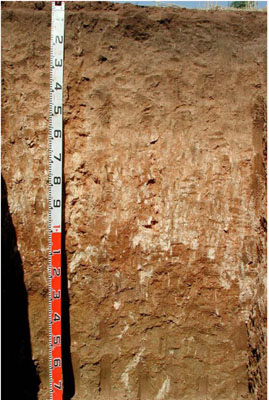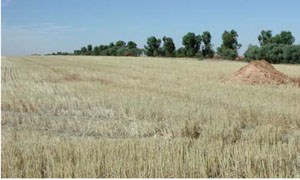WLRA130
|
| WLRA130 |  Epihypersodic, Regolithic, Hypercalcic Calcarosol | |
|
Location | Jeparit Road, Peppers Plains, western Victoria | |||
|
Landform | Undulating plain | |||
|
Geology | Quaternary Woorinen Formation: aeolian dune sand, calcareous clay | |||
|
Element | Lower slope | |||
|
Slope | 0–1% | |||
|
Aspect | North-west | |||
Horizon | Depth (cm) | Description | ||
A1 | 0–5 | Dark brown (10YR4/3); sandy clay loam; massive (structureless); earthy fabric; weak consistence dry; contains a few medium and fine calcareous nodules; highly calcareous; field pH 9.0; smooth and sharp change to: | ||
B21 | 5–25 | Dark greyish brown (10YR4/2); light clay, fine sandy; very coarse weak columnar structure; rough ped fabric; very firm consistence dry; contains very few fine calcareous nodules and fragments, very few fine gypseous nodules and very few fine argillaceous tubules; moderately cemented cultivation pan evident; highly calcareous; field pH 9.0; gradual and smooth change to: | ||
B22 | 25–50 | Yellowish brown (10YR5/4) with many medium faint greyish brown mottles; light clay, fine sandy; massive (structureless); earthy fabric; weak consistence, moderately moist; very few fine calcareous nodules and fragments and very few fine argillaceous tubules; highly calcareous; field pH 9.0; diffuse and smooth change to: | ||
B23k | 50–100 | Reddish yellow (7.5YR7/6); light clay; massive (structureless); earthy fabric; weak consistence, moderately moist; contains very many extremely coarse calcareous soft segregations and very few medium argillaceous tubules; very highly calcareous; field pH 9.5; gradual and wavy change to: | ||
2B21 | 100–145 | Yellowish red (5YR5/6) with many very coarse distinct greyish brown mottles; heavy clay; weak medium to coarse polyhedral structure; rough ped fabric; weak consistence, moderately moist; contains a few fine manganese flecks and a few extremely coarse calcareous nodules; highly calcareous; field pH 9.5; gradual and smooth change to: | ||
2B22 | 145–180+ | Yellowish brown (10YR5/4) with many very coarse distinct yellowish red mottles; light medium clay; coarse to very coarse strong lenticular structure; smooth ped fabric; weak consistence, moist; contains a few fine manganese flecks and very few extremely coarse calcareous nodules; highly calcareous; field pH 9.5. | ||
| Management Considerations | ||||
| ||||
Horizon | Depth (cm) | pH (water) | pH (CaCl2) | EC dS/m | Exchangeable Cations cmol-/kg | |||
Ca | Mg | K | Na | |||||
A1 | 0-5 | 8.4 | 8.2 | 2.3 | 12 | 3.3 | 1.4 | 3.1 |
B21 | 5-25 | 8.7 | 8.4 | 2.8 | 13 | 6 | 1.2 | 5.9 |
B22 | 25-50 | 8.9 | 8.7 | 1.9 | 8.6 | 7.5 | 0.7 | 5.3 |
B23K | 50-100 | 9.5 | 8.9 | 1.5 | 3.4 | 9.9 | 1.2 | 6.2 |
2B21 | 100-145 | 9.4 | 8.8 | 1.6 | 3.2 | 14 | 2 | 11 |
2B22 | 145-180+ | 9.4 | 9 | 1.5 | 2.2 | 13 | 1.9 | 10 |



